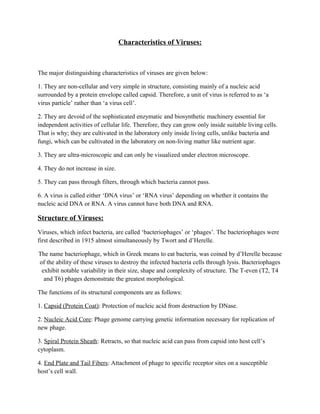
Characteristics of virus
- 1. Characteristics of Viruses: The major distinguishing characteristics of viruses are given below: 1. They are non-cellular and very simple in structure, consisting mainly of a nucleic acid surrounded by a protein envelope called capsid. Therefore, a unit of virus is referred to as ‘a virus particle’ rather than ‘a virus cell’. 2. They are devoid of the sophisticated enzymatic and biosynthetic machinery essential for independent activities of cellular life. Therefore, they can grow only inside suitable living cells. That is why; they are cultivated in the laboratory only inside living cells, unlike bacteria and fungi, which can be cultivated in the laboratory on non-living matter like nutrient agar. 3. They are ultra-microscopic and can only be visualized under electron microscope. 4. They do not increase in size. 5. They can pass through filters, through which bacteria cannot pass. 6. A virus is called either ‘DNA virus’ or ‘RNA virus’ depending on whether it contains the nucleic acid DNA or RNA. A virus cannot have both DNA and RNA. Structure of Viruses: Viruses, which infect bacteria, are called ‘bacteriophages’ or ‘phages’. The bacteriophages were first described in 1915 almost simultaneously by Twort and d’Herelle. The name bacteriophage, which in Greek means to eat bacteria, was coined by d’Herelle because of the ability of these viruses to destroy the infected bacteria cells through lysis. Bacteriophages exhibit notable variability in their size, shape and complexity of structure. The T-even (T2, T4 and T6) phages demonstrate the greatest morphological. The functions of its structural components are as follows: 1. Capsid (Protein Coat): Protection of nucleic acid from destruction by DNase. 2. Nucleic Acid Core: Phage genome carrying genetic information necessary for replication of new phage. 3. Spiral Protein Sheath: Retracts, so that nucleic acid can pass from capsid into host cell’s cytoplasm. 4. End Plate and Tail Fibers: Attachment of phage to specific receptor sites on a susceptible host’s cell wall.
- 2. Viral Infection: Phage replication depends on the ability of the phage particle to infect a suitable bacterial host cell. Infection consists of the following sequential events: 1. Adsorption: Tail portion of the phage particle binds to receptor sites on host’s cell wall. 2. Penetration (Infection): Spiral protein sheath retracts and an enzyme, early muramidase, perforates the bacterial cell wall enabling the phage nucleic acid to pass through the hollow core into the host cell’s cytoplasm. The empty protein shell remains attached to the cell wall and is called the protein ghost. 3. Replication: The phage genome subverts the synthetic machinery, which is then used for the production of new phage components. 4. Maturation: The new phage components are assembled and form complete, mature virulent phage particles. 5. Release: Late muramidase lyses the cell wall, liberating infectious phage particles that are now capable of infecting new susceptible host cells, thereby starting the cycle over again. Shape of Viruses: The shape of some of the important viruses has been revealed by electron microscope. All of them cause different diseases in plants and animals. The bacteriophages infect bacteria cells.